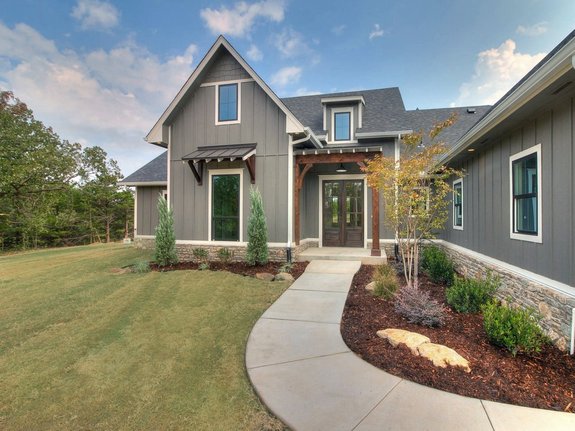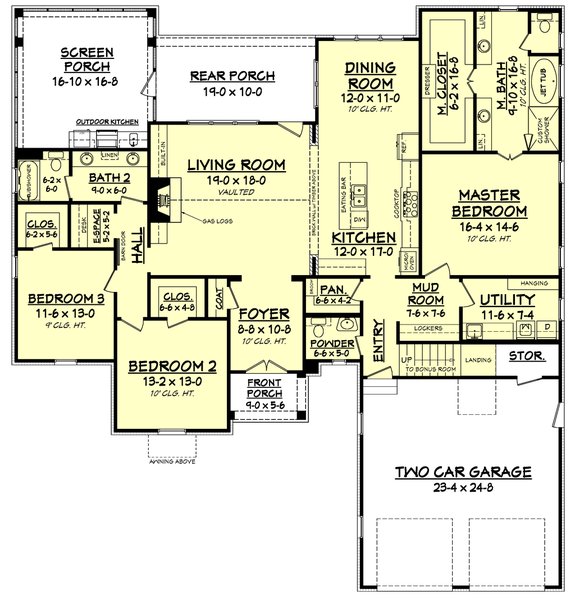By Boyce Thompson
Every house needs a strong foundation. But the ideal foundation plans for your home differs by soil type, lot slope, house style, and climate. Because house plans are often available with foundation options, it’s a good idea to know whether you are doing a slab, crawlspace, or basement before you buy.
Click here to browse our walk-out basement house plans.
Foundations, of course, need to be strong enough to support the load of the house. House plan designers take care of that when they draw the foundation diagrams that come with a house plan (most house plans include the footing layout, post and beam locations, and the size of the structural slabs). The problem is that foundation plans are intended for universal soil conditions – soil that’s dry, settled, and undisturbed.
Your building lot may present special challenges. Unless you are certain of the soil conditions, you may want to hire an engineering company to drill test holes in the ground to determine the type of soil at different depths, its moisture content, and its compaction (take a look at this land development checklist from NAHB). The test may turn up clay or sandy soil, bedrock deep underground, or a high water table, findings that influence the type of foundation that is right for your home. Here are the strengths and limitations of the three basic options.
Slab
Concrete slabs, the least-expensive option, are also the most common; they are found on slightly more than half of new homes built today. That’s because they are easy to build and require minimal excavation. Slabs are the foundation of choice in warm climates where frost isn’t an issue – they dominate new construction in the South. They may not be the best choice in colder climates. When the ground freezes and thaws through the seasons, it may cause the slab to crack and shift.
Since they are built directly on the ground – sometimes over a bed of gravel – the soil under a slab foundation needs to be level, otherwise the slab may crack or break down. That makes slabs an unlikely candidate for a steeply sloping lot (a crawlspace may work better there). But they may be the foundation of choice on lots with high water tables where building a basement would be problematic.
To create a slab foundation, four to six inches of concrete, reinforced with steel bars, is poured over a mesh and moisture barrier. Trenches are dug around the perimeter of the slab for footings to support walls. Concrete footings may be poured to support interior walls and columns as well. Below is a modern farmhouse plan that comes with a slab foundation as a standard option (crawlspace is also standard, and basement is available for a fee).
Plan 1067-1 sports an open layout and cool screened porch.


One drawback to slab construction is that mechanical and sometimes even electrical systems are buried underneath the slab. That can make them difficult to repair or replace. Slabs need to be carefully insulated to prevent thermal conduction issues, and they need to be protected from moisture and run-off damage.
Slabs can be polished into a finished floor. Properly insulated, they can double as thermal mass, capturing heat during the day and radiating it back into the house at night. They can also serve as a home for a radiant heating system, a popular option in colder climates. Radiant heating obviates the need for ductwork, which can be a source of poor indoor air quality. Here’s a classic passive solar home, plan , with radiant heating built on a slab.
Plan is inspired by the classic designs of Frank Lloyd Wright.


Crawlspace
The beauty of a crawlspace foundation, compared to a slab, is that you can access mechanical, plumbing, and even electrical systems with relative ease. That’s because these systems are run through crawlspace, which is typically at least two feet high so that you can get under the house to do the work. With a crawlspace foundation, your builder pours foundation footings and walls support the house. Local codes may call for installing a capillary break on the top of the footing and between the foundation wall and framing.
Crawlspace foundations, which account for about 15 percent of new homes, may be the best choice for a sloped lot, since footings can be used to level the home’s flooring. Soils like red clay almost always require one because they aren’t strong enough to support a cement slab. Crawlspaces may also prove the best option in flood-prone areas, since they keep the house elevated above ground level. But the first floor needs to be elevated above flood plain levels published by the Federal Emergency Management Agency. Below, you will see a modern farmhouse (for DIY farmhouse decorating ideas, check out this blog from HGTV) that comes standard with a crawlspace foundation, though a basement is also available.
Plan 430-223 features a welcoming front porch and country kitchen.


Plan 890-1 (below) is an elevated modern cottage house plan that features a distinctive crawlspace foundation.


You see many older homes with vented crawlspaces. They often become damp, moldy, and home to pests. Building scientists recommend that crawlspaces in new homes today be designed as mini-basements, with foam-insulated walls and conditioned air. That allows mechanical equipment to run more efficiently, saving energy costs in the long run. The floor of the crawlspace should not be insulated; only the walls. The ground under the crawlspace should be covered with a vapor barrier to prevent mold from forming. The ground should also slope away to a drain in case the plumbing leaks. Many bungalow plans feature crawlspace foundations, like plan 923-134 below.
Plan 923-134 boasts an easygoing layout with a country kitchen.



Basement
It’s even easier to install and maintain mechanical systems in basements, of course. They make an ideal location for heaters, air conditioners, and electrical equipment, especially when carefully insulated and conditioned. They can also hold fun recreational spaces like wet bars, family rooms, guest suites, and even sport courts!
Basements are most common in the Northeast or Midwest where the soil is more conducive to them. About one third of new homes have basements. The basement in this large home (plan 928-12 from Visbeen Architects) includes space for a home theater, billiards, and a guest suite.
Plan 928-12 has a super open layout that and plenty of outdoor living spaces.



If you are building in a cold climate, you may have to dig below the frost level – a good four feet in many regions – to pour footings. In that case, you can bite the bullet, dig a little deeper, and build a full basement. Though it will add thousands of dollars to the cost of your home, basements add comparatively cheap living space. They are particularly attractive on sloped lots that allow you to walk out to the backyard (check out these hillside havens from Builder Online). The configuration also provides more natural light. Plan 117-886 is perfect for a mountain location and is designed with a walkout basement.
Plan 117-886 features a main-level master for extra privacy.



Plan 437-88 (below) is another plan with impressive living space in the walkout basement.



Basements need to be treated like other living spaces within the home so that they aren’t cold and damp. Basement walls should be cloaked with air-tight, foam insulation. The idea is to prevent warm, moist interior air from contacting cold basement surfaces. Otherwise condensation and wetting will result. Providing rigid insulation under basement floor slabs has also been proven to improve comfort and avoid moisture damage. Building Science Corporation recommends applying a polyethylene vapor barrier over the rigid insulation and in direct contact with the concrete slab. You may not want to build a basement on lots with high water tables or shallow bedrock or boulders.
Basement walls can be formed in a variety of fashions – poured concrete, stacked concrete blocks, insulated concrete panels. A key to keeping them dry often has nothing to do with how they are built. You need to make sure water drains away from the perimeter of the home. That means collecting run-off from roofs and sloping the lot away from the home. That’s best practice no matter which foundation is best for your home.
Explore Walkout Basement
See Basement
Find plans for your area (though local stamping/approvals may still be required) with Regional






